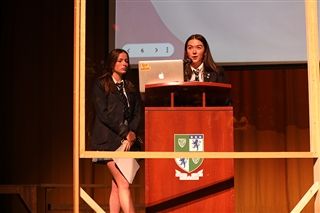Grade 12 students Hopper Kendregan and Lainey Hunt have taken on a role within the Senior School to help educate their peers about harm reduction. They were influenced by Jessica Soule ‘20, who helped start the conversation about harm reduction by introducing naloxone training in 2018. Personal experiences also motivated Lainey and Hopper to keep this important conversation going.
“When we were 13, a childhood friend of mine overdosed,” said Lainey. “That was an eye opening experience for me—that was the first time I knew this was an issue. It was someone I spent summers with and who I knew; it made it more real and personal.”
Additionally, Hopper and Lainey have been influenced by the stories of other young students throughout the city who have overdosed over the last couple of years.
“It’s shocking there are people this young that it’s happening to,” said Hopper. “Lainey texted me this summer and said we should do something, and we started looking around websites to find contacts who work in harm reduction at Island Health.”
When they first started their research, they said they were more focused on naloxone training, but their goal has since evolved into something bigger than they expected.
“I learned that harm reduction has so many faces to it,” said Lainey. “It’s not just one thing that’s going to solve everything. There are so many factors, like destigmatizing our language and minds and acting with compassion. There is so much information that is necessary to help prevent overdose deaths.”
“We thought kids should be trained in naloxone, so if any kids are in a situation where they are witnessing an overdose, they can do something and someone’s life can be saved. We consider carrying naloxone to be an essential and contemporary form of first aid in the midst of the toxic drug supply crisis,” added Hopper. “As we were learning more about harm reduction and naloxone and all of these resources that are available to us, we started thinking we should be sharing everything. That’s how we came to the idea of holding a full assembly about it.”
They worked with Nurse Susan Duffell-Warthe and a representative from the Vancouver Island Health Authority that supported them in their training and presentation materials. On October 20, Lainey and Hopper led a Senior School assembly on harm reduction. They chose to present the information themselves, as it would be more meaningful coming from a peer.
“I think talking about the risks of drug use comes across better from us rather than just an adult saying ‘drugs are bad’ ,” said Hopper. “We figured coming from peers their own age with a balanced perspective, it would be more effective.”
Throughout their presentation they wanted to stress it wasn’t about condoning drug use, but about education in general.
“One of the facets of harm reduction is meeting people where they are, and the goal of harm reduction isn’t necessarily recovery. The goal of harm reduction is for people to be safe, alive and healthy,” said Hopper. “Regardless of the moral value that might be assigned to people who use drugs, anyone who chooses to use or not to use drugs still has the right to dignity and the highest attainment of health that they can achieve. Everyone has the right to life.”
“We aren’t assuming people in our community use drugs,” added Lainey. “What you have to take into account is that we live in the province that is the most affected by this toxic illicit drug supply. I’ve been at work and people have overdosed in front of me. It’s about arming people in our community with naloxone, or knowledge of the first couple steps of SAVE ME (Stimulate, airway, ventilate, evaluate, medication, evaluate and support).”
When it came to talking about harm reduction, informed consent about each individual’s own body was at the top of the list.
“If people are going to do drugs, that’s their choice, but if they are going to, I want anyone in the community to be doing it safely, and I want them to be informed so they can make informed decisions for themselves,” said Lainey.
Hopper and Lainey noted that they hope to keep helping their peers stay informed and, to continue with naloxone training for those who want to participate. They also want to provide other resources about the different types of harm reduction as well as health and wellness.
“Even if people think it doesn’t apply to their community, well what if it does?” said Hopper. “What if there is that one kid that really needs to hear this—I think it makes it worth it.”





